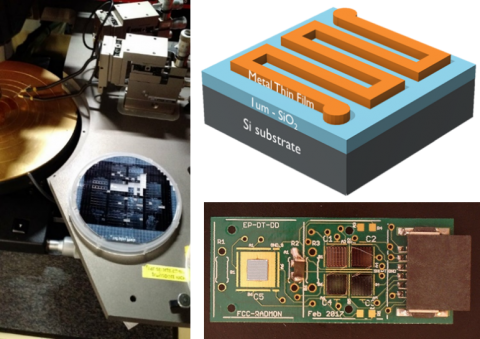DT group: A year in review
 In the beginning of June, the EP-DT group has published its Annual Report summarizing its yearly activities and offering an overview of major achievements and future collaborative plans.
In the beginning of June, the EP-DT group has published its Annual Report summarizing its yearly activities and offering an overview of major achievements and future collaborative plans.
The Detector Technologies (DT) group comprises expertise in many key domains for advanced detector systems and engages in several detector projects both for LHC and non-LHC experiments. Moreover, it operates services for detector operation and infrastructures for research & development open to all CERN users around the world. The DT group is also involved in R&D for future experiments.
Burkhard Schmidt, DT group leader, notes: “The 2018 annual report reflects the high motivation of the group. The work is carried out in close collaboration with teams from CERN experiments who value DT’s contributions. In the same spirit, we are eagerly looking forward to a strong participation in the strategic R&D for future experimental efforts.”
One of the core activities of the group has been the participation to the upgrades of ALICE and LHCb sub-detector systems scheduled for LS2. For ALICE, the upgrade programme includes a new beampipe with a smaller diameter, a new Inner Tracking System (ITS), a vertex tracker for forward muons (MFT), the upgrade of the Time Projection Chamber (TPC) with GEM detectors, the upgrade of the forward trigger detectors and the upgrade of the online and offline system. DT is involved in the upgrade of the new ITS. For LHCb, the upgrade includes a new VELO detector and the installation of a Scintillating Fiber tracker replacing the current Outer Tracker (based on gas straw tubes) and Inner Tracker (Silicon micro-strips). Finally, DT contributes to these upgrades and the ones for the LHCb upstream tracker, RICH detector and muon system.
In 2018, the DT group continued playing an important role in the ATLAS Phase II Upgrade. The DT efforts focus on the mechanical integration of the Outer Layers for the new Pixel Detector. For the CMS Tracker’s Phase II upgrade, as well scheduled for installation during LHC LS3 in 2025, the DT group collaborates with the CMS team in the development and construction of the Outer Tracker as well as in the CMS High Granularity Calorimeter (HGCAL). Group members are also actively involved in the operation and upgrade of non-LHC experiments including CLOUD and NA62, and provide technical support to ISOLDE.
In 2018, the group was heavily involved in the preparation of a new strategic R&D programme on experimental technologies, launched by the CERN EP department. The programme builds on CERN’s current expertise and covers the domains of detectors, electronics and software together with intimately connected systems such as mechanics, cooling and experimental magnets. These efforts are also reflected in the group’s contribution to design plans for post-LHC colliders.
Finally, 2018 show a number of facilities offering sophisticated equipment for the development of new detector technologies. The CERN Gamma Irradiation Facility (GIF++) offers a unique place for detector R&D tests where a strong gamma source and a muon particle beam are simultaneously available. Moreover the proton irradiation facility (IRRAD) at the PS East Area concluded successfully the first run of this facility which is operational since the LS1 with more than 2500 samples irradiated. During 2018, the proposal for the extension of the GIF++ and the IRRAD technical areas was accepted. The year 2019 will be dedicated to the thorough maintenance and upgrade of the various irradiation systems. IRRAD is also part of the AIDA-2020 Transnational Access (TA) to irradiation facilities program that provides funding for external users to perform their irradiation tests at CERN and as of today 18 projects and 76 users have been given access to test their components under conditions that are as close as possible to real applications.
In 2018, new equipment was also installed in a number of other labs among which Thin-Film Lab, the Bond Lab, the Solid State Detector Lab and the Quality Assurance and Reliability Lab. A milestone for the DT group was also the installation of the Micropattern Technologies workshop in the new building 107. This development will allow to continue with the mass production of Micro Pattern Gas Detectors (GEM and MircoMegas) under much improved conditions and according to the high standards requested by the experiments.
The 2018 Annual Report can be found HERE.
